Nation’s First Operational Satellite in Deep Space Reaches Final Orbit

More than 100 days after it launched, NOAA’s Deep Space Climate Observatory (DSCOVR) satellite has reached its orbit position about one million miles from Earth.
Once final instrument checks are completed, DSCOVR, which will provide improved measurements of solar wind conditions to enhance NOAA’s ability to warn of potentially harmful solar activity, will be the nation’s first operational space weather satellite in deep space. Its orbit between Earth and the sun is at a location called the Lagrange point 1, or L1, which gives DSCOVR a unique vantage point to see the Earth and sun.
Data from DSCOVR, coupled with a new forecast model set to come online in 2016, will enable NOAA’s space weather forecasters to predict geomagnetic storm magnitude on a regional basis. Geomagnetic storms occur when plasma and magnetic fields streaming from the sun impact Earth’s magnetic field. Large magnetic eruptions from the sun have the potential to bring major disruptions to power grids, aviation, telecommunications, and GPS systemsDSCOVR will trigger early warnings whenever it detects a surge of energy that could cause a geomagnetic storm that could bring possible damaging impacts for Earth,” said Stephen Volz, Ph.D., Assistant Administrator for NOAA’s Satellite and Information Service.

On June 20, 2013, NASA's Solar Dynamics Observatory spacecraft captured this coronal mass ejection (CME). A solar phenomenon that can send billions of tons of particles into space that can reach Earth within three days.
Credits: NASA
DSCOVR will eventually replace NASA’s Advanced Composition Explorer (ACE) research satellite as America’s primary warning system for solar magnetic storms headed towards Earth. ACE will continue to provide valuable research data to the science community.
In addition to space weather-monitoring instruments, DSCOVR is carrying two NASA Earth-observing instruments that will gather a range of measurements from ozone and aerosol amounts, to changes in Earth's radiation budget—the balance between incoming radiation (largely from the sun) and that which is reflected from Earth. This balance affects our climate.

An aurora as seen over the Poker Flat Research Range north of Fairbanks, Alaska, on Feb. 28, 2011.
Credits: NOAA
"DSCOVR has reached its final orbit and will soon be ready to begin its mission of space weather monitoring for NOAA and Earth observing for NASA," said Al Vernacchio, DSCOVR project manager at NASA's Goddard Space Flight Center, Greenbelt, Md.
NOAA’s Space Weather Prediction Center in Boulder, Colo., will begin using data from DSCOVR in its space weather forecasts as soon as DSCOVR is deemed operational.
The DSCOVR mission is a partnership between NOAA, NASA, and the U.S. Air Force. The Air Force provided the Space X Falcon 9 launch vehicle for the mission. NOAA will operate DSCOVR from its NOAA Satellite Operations Facility in Suitland, Md., and process the space weather data at NOAA’s Space Weather Prediction Center (SWPC) in Boulder, Colo., one of NOAA’s nine National Centers for Environmental Prediction. SWPC will distribute these data to users within the United States and around the world. The data will be archived at NOAA’s National Center for Environmental Information.
DSCOVR also hosts NASA-funded secondary sensors for Earth and space science observations. The Earth science data will be processed at NASA’s DSCOVR Science Operations Center and archived and distributed by NASA’s Atmospheric Science Data Center.
For more information about DSCOVR, visit: http://www.nesdis.noaa.gov/DSCOVR/
John Leslie
NOAA
Bron:http://www.nasa.gov/feature/goddard/nation-s-first-operational-satellite-in-deep-space-reaches-final-orbit
M1.3 zonnevlam
An eruption off the west limb registering as an M1.3 solar flare was observed by the Solar Dynamics Observatory (SDO) during the early hours of June 18, 2015. The event likely hurled a coronal mass ejection (CME) into space, but due to the location behind the west limb, is more than likely to be directed away from our planet. No major Earth impacts are to be expected. Elsewhere, minor C-Flares were detected around both regions 2367 and 2371. An isolated M-Flare will remain possible during the next day. Attached video courtesy of SDO using both the 94 and 171 angstroms channel. Stay tuned to SolarHam.com for the latest information.


Bron: http://solarham.net/
M3.0 klasse zonnevlam
Attached is an updated video presentation capturing an M3.0 eruption and coronal mass ejection (CME) event on Thursday generated by big sunspot 2371. Although current tracking models differ, based on coronagraph imagery, the western edge of the full halo CME could deliver a glancing blow to our geomagnetic field by Sunday (June 21). Sky watchers at high latitudes should be alert for visual aurora displays should local weather and light conditions allow. More updates regarding this to follow when necessary.Region 2371, with a Beta-Gamma-Delta (BGD) magnetic structure, continues to move into a more geoeffective Earth facing position and will remain a threat for moderate to strong solar flares.Attached video imagery courtesy of the Solar Dynamics Observatory (SDO) and LASCO.
Bron:http://solarham.net/
Severe Geomagnetic Storming / Aurora Warning
Moderate (G2) to Severe (G4) geomagnetic storming continues at middle to high latitudes following a coronal mass ejection (CME) impact on Monday. An interplanetary shock measuring 112 nT was detected at 18:37 UTC signalling the passage. Visual aurora displays are likely tonight if you are located at higher latitudes.More storming will be possible in the days ahead as another CME looks to be on its way following an M6.5 solar flare around region 2371 on Monday. The latest tracking model released by NOAA shows early on June 25 as a possible arrival time past Earth. Stay tuned.
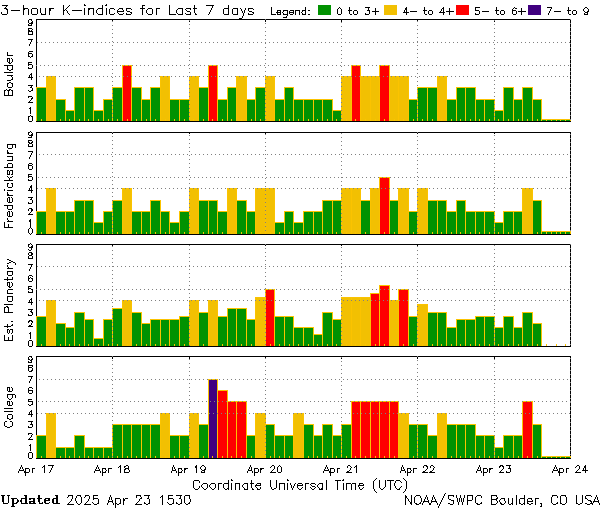

Bron: http://solarham.net/
In principe is er een topic over aurora's, maar ik wilde hier het resultaat laten zien van bovenstaande artikel.
SOLSTICE GEOMAGNETIC STORM:
A series of CMEs hit Earth's magnetic field on June 22nd, producing a severe G4-class geomagnetic storm. Northern Lights spilled across the Canadian border into more than a dozen US states, including places as far south as Colorado, Virginia, Arkansas and Kansas. Chris Cook sends this picture from Cape Cod, Massachusetts: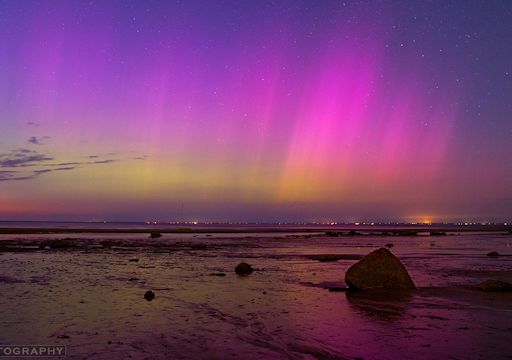
Photo Chris Cook
The auroras did not disappoint this evening!" says Cook. "I captured this view in deep twilight, positioning myself on a beach overlooking Cape Cod Bay so I could capture the reflection in the water at low tide."
More auroras are in the offing as Earth's magnetic field reverberates from the CME strikes. NOAA forecasters estimate a 90% chance of polar geomagnetic storms on June 23rd, subsiding only a little to 70% on June 24th.
Bron: http://www.spaceweather.com/ | Gewijzigd: 1 februari 2017, 11:31 uur, door Joyce.s
M 7.6 zonnevlam en radio black out
Today, Sept. 28th at 1458 UT, a strong M7-class solar flare erupted in the magnetic canopy of sunspot AR2422. Extreme UV radiation from the flare ionized the top of Earth's atmosphere and caused a brief low-frequency radio blackout over South America and the Atlantic ocean: blackout map. AR2422 has an unstable 'beta-gamma-delta' magnetic field that could erupt again at any moment. NOAA forecasters estimate a 40% chance of additional M-class solar flares and a 5% chance of X-flares during the next 24 hours


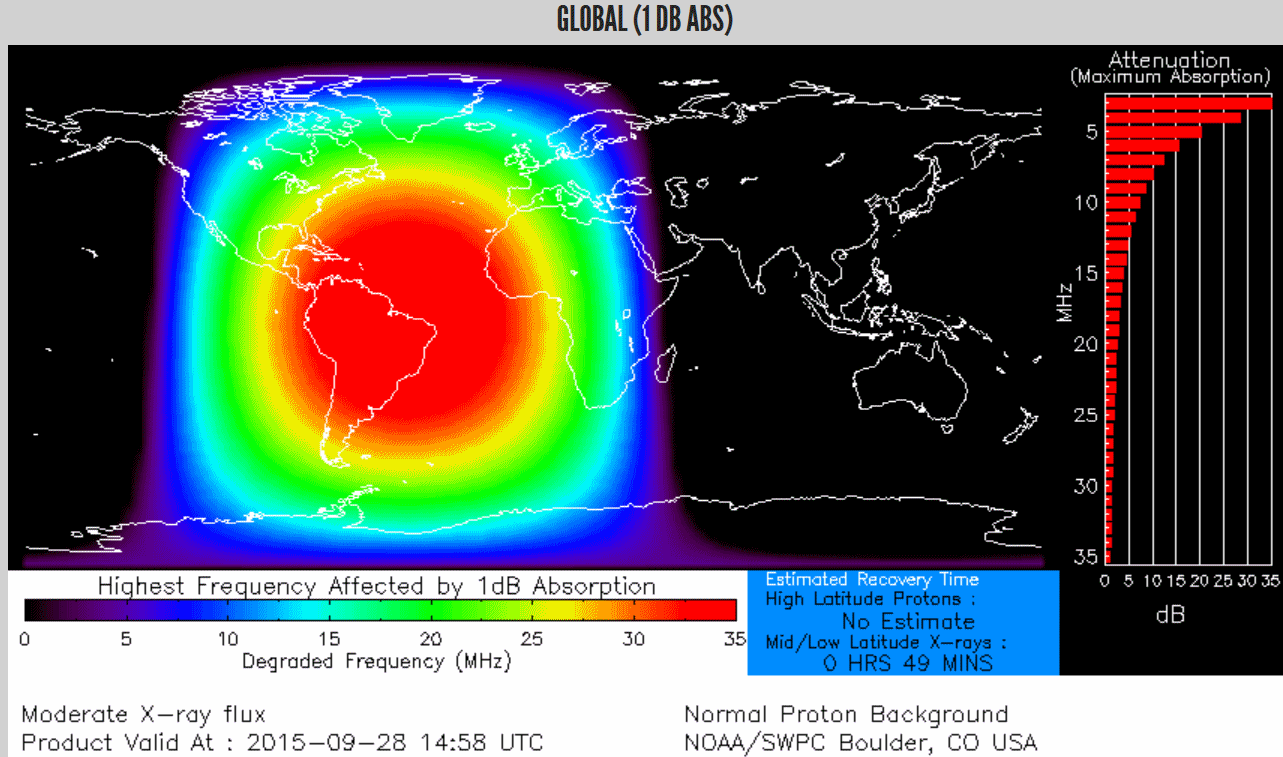
Bronnen:
http://www.spaceweather.com/
http://solarham.net/
http://services.swpc.noaa.gov/images/goes-xray-flux.gif
ENORMOUS CORONAL HOLE
A gigantic hole in the sun's atmosphere has opened up and a broad stream of solar wind is flowing out of it. This is called a "coronal hole." It is the deep blue-colored region in this extreme UV image from NASA's Solar Dynamics Observatory: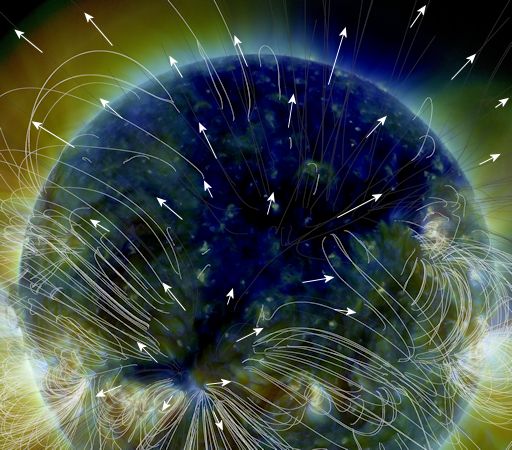
Coronal holes are places in the sun's atmosphere where the magnetic field unfurls and allows solar wind to escape. In the image above, the sun's magnetic field is traced by white curving lines. Outside the coronal hole, those magnetic fields curve back on themselves, trapping solar wind inside their loops. Inside the coronal hole, no such trapping occurs. Solar wind plasma is free to fly away as indicated by the white arrows.
For much of the next week, Earth's environment in space will be dominated by winds flowing from this broad hole. This should activate some beautiful Arctic auroras. NOAA forecasters estimate a 65% of polar geomagnetic storms today as Earth moves deeper into the solar wind stream.
Bron: http://www.spaceweather.com/
Update zon

Solar activity during the past 24 hours was low with a number of C-Flares detected around new region 2434, now turning into view off the east limb. This looks to be the return of old sunspot 2423 from this previous rotation. Additional C-Flares will be possible with a chance for an isolated M-Flare. All other regions are currently stable.Attached image below by the Solar Dynamics Observatory (SDO) captures a prominence eruption off the northeast limb Tuesday evening. A quantity of plasma may have been flung into space leading to a possible coronal mass ejection. Due to the non Earth facing locaton, it will be directed away from our planet. Still a great looking capture!
With a large coronal hole now rotating into a geoeffective position, a geomagnetic storm watch has been expanded to include the next 3 days. Sky watchers at higher latitudes should remain alert for visual aurora displays.



Bronnen: http://solarham.net/
http://sohowww.nascom.nasa.gov/data/realtime/c3/512/latest.jpg
http://sohowww.nascom.nasa.gov/data/realtime/c2/512/latest.jpg
http://services.swpc.noaa.gov/images/planetary-k-index.gif
Geen krachtige, maar een urenlang durende zonnevlam
Magnetic fields around sunspot AR2434 erupted during the early hours of Oct. 22nd, producing a solar flare that lasted for hours. NASA's Solar Dynamics Observatory took this extreme UV picture of the eruption: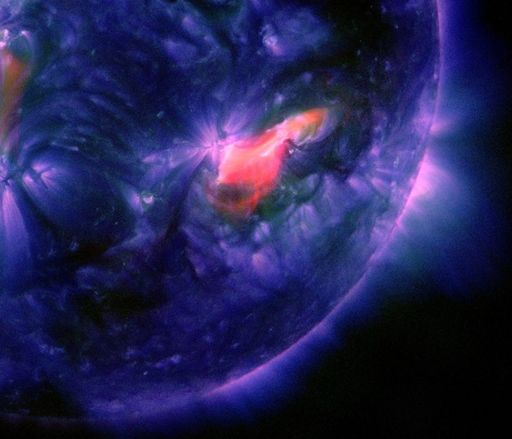
The peak X-ray intensity of the flare was relatively low; on the Richter Scale of Solar Flares it registered only C4. What the flare lacked in amplitude, however, it made up for in longevity. The hours-long blast was powerful and produced a bright CME:movie. The CME does not appear to be heading directly for Earth, but it might have an Earth-directed component. This is a preliminary conclusion based on limited data, so stay tuned for updates.
Bron: http://www.spaceweather.com/
SIGNIFICANT FARSIDE EXPLOSION
Yesterday, Oct. 29th, something exploded on the farside of the sun. It was probably a sunspot. NASA's Solar Dynamics Observatory saw material flying over the edge of the solar disk (movie), while the Solar and Heliospheric Observatory (SOHO) recorded a significant CME: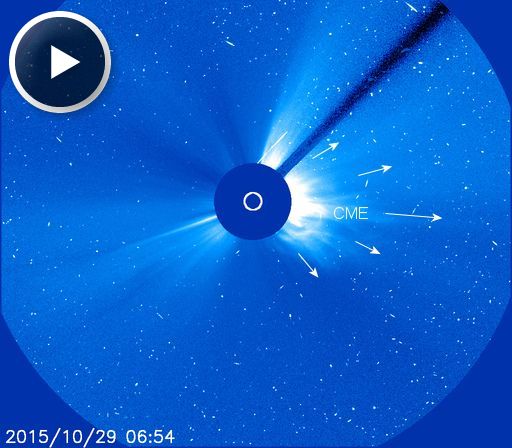
The explosion was so strong, it peppered Earth with energetic particles despite the fact that the blast site was hidden behind the body of the sun. You can see the effect of those particles by playing this movie. The speckles aren't stars. They are energetic protons from the sun striking SOHO's onboard CCD camera. Fogging spacecraft cameras is just one of many things a surge in solar protons can do; other effects include degrading the efficiency of solar arrays, causing satellite computers to re-boot, and ionizing Earth's upper atmosphere. The "proton storm" of Oct. 29th is subsiding now.
The blast site will spend the next 10 days or so transiting the farside of the sun, carried around by the 27-day spin of our star. If it still exists at the end of that trip, the active region will emerge onto the Earthside of the sun, and we will see what exploded. Stay tuned.
Bron:http://www.spaceweather.com/
M1.9 zonnevlam, niet aarde gericht:
http://sohowww.nascom.nasa.gov/data/realtime/c3/512/latest.jpg

http://sohowww.nascom.nasa.gov/data/realtime/c2/512/latest.jpg

Zonnevlek 2445 produceerde de M1.9

http://www.solarham.net/pictures/regions2.jpg | Gewijzigd: 4 november 2015, 12:23 uur, door Joyce.s
M3.7 zonnevlam met cme
Onze zon blijft zich nu even roeren. Een zonnevlam M3.7 met cme naar het zuiden en westen van onze aarde gericht. Er is een kans dat een deel toch onze kant op komt. We houden het in de gaten i.v.m. eventueel noorderlicht dat straks zichtbaar zal kunnen zijn.Deze keer was zonnevlek 2443 de oorzaak. Voor degene die het niet weten: hoe meer de rode en blauwe gebieden mixen hoe groter de kans op een flinke zonnevlam

http://www.solarham.net/pictures/regions2.jpg

http://sohowww.nascom.nasa.gov/data/realtime/c2/512/latest.jpg
to be continued....


Bijna een dag eerder dan verwacht is de cme gearriveerd in de vorm van een G2 klasse geomagnetische storm. Voor foto's van de aurora borealis, zie onze aurora galerij | Gewijzigd: 7 november 2015, 09:25 uur, door Joyce.s
M 3.9 zonnevlam met cme:
A surprise solar flare was detected around sunspot 2449 on Monday at 13:12 UTC. Attached video below courtesy of the Solar Dynamics Observatory (SDO) captures the event in multiple wavelengths. As of this update, full coronagraph imagery courtesy of LASCO C2 is still unavailable. What is available does show a CME emerging from the blast site and appears to be directed mostly to the south and east. More updates regarding a possible Earth directed component once additional imagery becomes available.Bron: http://solarham.net/
EARTH-DIRECTED CME?
Yesterday, Nov. 9th, the magnetic canopy of sunspot AR2449 erupted, producing an M3-class solar flare and a bright CME. Radio emissions from shock waves in the CME suggest that it blew away from the sun faster than 950 km/s (2 million mph). The Solar and Heliospheric Observatory recorded the expanding cloud: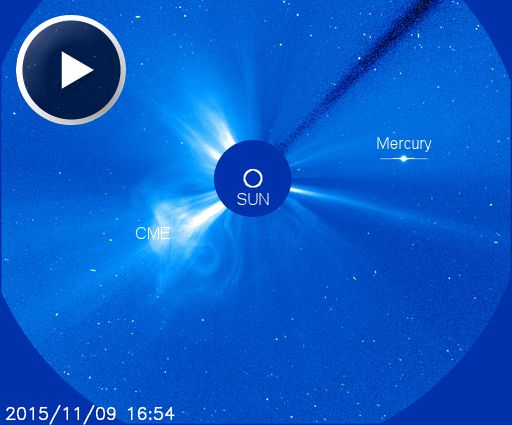
The CME is not heading directly for Earth. Nevertheless, a glancing blow from the CME's flank is possible later this week. NOAA forecasters are modelling the CME now, and they expect to have a storm track on Nov. 10th.
Bron:http://www.spaceweather.com/
http://services.swpc.noaa.gov/images/goes-xray-flux.gif
http://services.swpc.noaa.gov/images/goes-proton-flux.gif
http://services.swpc.noaa.gov/images/planetary-k-index.gif
http://solarham.net/pictures/regions2.jpg
Enorm coronaal gat op de zon ontstaan.
De zonnewind zal rond 6 december de aarde bereiken en enkele dagen aanhouden. Dus wellicht weer mooie beelden van aurora borealis.A vast hole in the sun's atmosphere--a "coronal hole"--has opened up in the sun's northern hemisphere, and it is spewing a broad stream of solar wind into space. NASA's Solar Dynamics Observatory photographed the coronal hole during the early hours of Dec. 3rd:

Coronal holes are places where the sun's magnetic field opens up and allows solar wind to escape. Hot plasma flows outward at speeds exceeding a million mph. In the extreme-ultraviolet image, above, the boundaries of the coronal hole are traced by dashed lines; arrows indicate the escape of hot plasma.
Solar wind flowing from this coronal hole will reach Earth beginning ~Dec. 6th, and our solar wind environment will be dominated the stream for days after first contact. High-latitude sky watchers should be alert for auroras
Bron:http://www.spaceweather.com/
De cme afkomstig van het coronale gat is gearriveerd.

Dit is een G1 klasse storm. Hieronder de schaalverdeling uitleg:
G-schaal Kp Poollicht activiteit Gemiddelde frequentie
G0 4 en lager Actief
G1 5 Kleine storm 1700 per cyclus (900 dagen per cyclus)
G2 6 Matige storm 600 per cyclus (360 dagen per cyclus)
G3 7 Sterke storm 200 per cyclus (130 dagen per cyclus)
G4 8 Zeer sterke storm 100 per cyclus (60 dagen per cyclus)
G5 9 Extreme storm 4 per cyclus (4 dagen per cyclus)
Bronnen:
http://www.swpc.noaa.gov/products/planetary-k-index
http://www.poollicht.be/nl/help/de-kp-index
2 cme's, mogelijk aarde gericht

Two coronal mass ejections to report today, both of which appear to have an Earth directed component. The first CME was the result of a C6.6 solar flare that I first reported on earlier this morning at 09:03 UTC (Dec 16). This CME appears to have faint full halo characteristics and could impact our planet by early this weekend. The second and somewhat brighter, full halo coronal mass ejection was the result of an eruptive event along a filament channel in the southeast quadrant beginning at 13:45 UTC. This too may impact our geomagnetic field by early this weekend. The combination of both events may trigger geomagnetic storming which could be great news for aurora sky watchers. More updates later this evening. Stay tuned to SolarHam.com for the most up to date information.
Storm Watch Added: The WSA-ENLIL Solar Wind Prediction model released by the NOAA Space Weather Prediction Center has been updated to include a pair of coronal mass ejections observed on Wednesday. An impact to our geomagnetic field is forecast for late Friday night (UTC) and into early Saturday morning. A minor (G1) to moderate (G2) geomagnetic storm watch has been added for the next 48 hours. Sky watchers at higher latitudes should be alert for visual aurora displays this weekend.
Bron:http://solarham.net/
Update 20 december:
De cme is gearriveerd en produceert een G2 klasse storm:

.


Bron:http://solarham.net/
| Gewijzigd: 21 december 2015, 09:39 uur, door Joyce.s
M2.8 klasse zonnevlam:
We hebben er even op moeten wachten, maar de zon heeft weer eens een M klasse zonnevlam geproduceerd.In addition to the geomagnetic storm, we have an actual solar flare to report. The actve region hiding off the east limb produced an M2.8 flare peaking at 01:03 UTC (Dec 21). This new region will likely be assigned number 2472. We will get a better look at it during the next several days as it moves into Earth view. Image below by the Solar Dynamics Observatory using the 131 angstroms channel.

Bron: http://solarham.net/
M4 klasse zonnevlam en radio blackout
In the past 24 hours, sunspot AR2473 has quadrupled in size. On Dec. 23rd (00:40 UT) it erupted, producing an M4-classsolar flare. NASA's Solar Dynamics Observatory recorded the extreme ultraviolet flash:
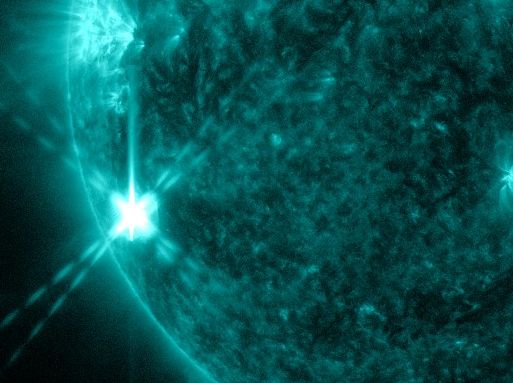
UV radiation from the flare bathed the top of Earth's atmosphere, ionizing atoms and molecules, and altering the normal propagation of radio transmissions. Around the South Pacific Ocean, where the sun was high in the sky, a full-fledged shortwave radio blackout occured. This map from NOAA shows the affected area:
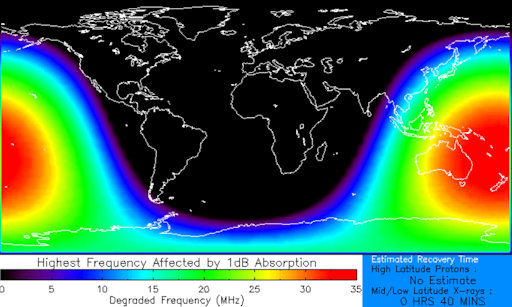
The type of people who would notice such a blackout are ham radio operators, mariners, and some aviators who use shortwave radio in their work. The event lasted approximately half an hour.
More flares and blackouts are possible in the days ahead as AR2374 turns toward Earth. NOAA forecasters estimate a 45% chance of M-class explosions on Dec. 23-24.
Bron:http://www.spaceweather.com/

 Uitbarstingen van de zon en impact op de aarde
Uitbarstingen van de zon en impact op de aarde




